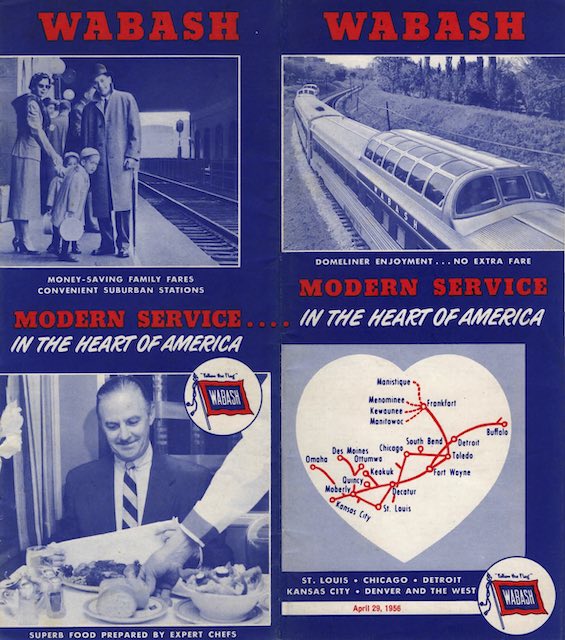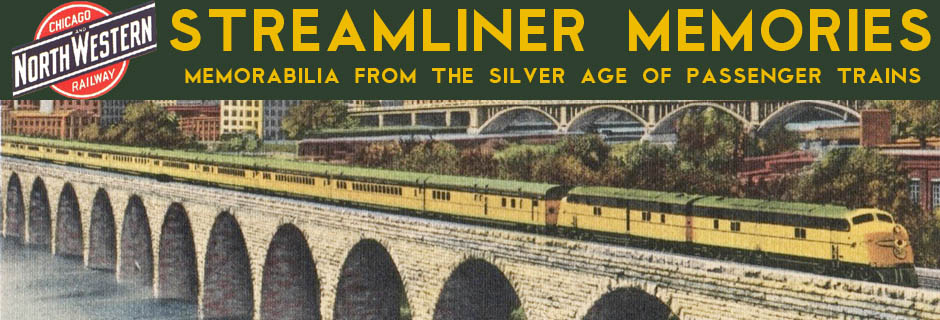In 1956, the Wabash had three trains a day between St. Louis and Kansas City, one of which was Union Pacific’s connection to St. Louis. It also had three trains a day in the hotly competitive Chicago-St. Louis market and two trains a day between Detroit and St. Louis. One of the Chicago-St. Louis trains offered a through sleeping car to Dallas via the Frisco-MKT Texas Special.
 Click image to download a 13.2-MB PDF of this timetable from the Ellery Goode collection.
Click image to download a 13.2-MB PDF of this timetable from the Ellery Goode collection.
On the St. Louis-Kansas City route, the domerliner City of St. Louis connected with the UP, but the City of Kansas City was also a domeliner that was timed to go from St. Louis to Kansas City in the morning and return an hour later in the afternoon, thus requiring only one set of equipment. In contrast, the overnight Midnight Limited required two sets of equipment since the trains left and arrived at the termini at roughly the same times.
Similarly, on the Chicago-St. Louis route, the domeliner Blue Bird was timed to leave St. Louis in the morning and return in the evening, after a 2-1/2 hour layover in Chicago. The Banner Blue and overnight Midnight each required two sets of equipment. The back cover of this timetable notes that the Blue Bird not only had four dome cars, it offered rooms beneath some of the domes that could be reserved for private meetings.
The Detroit-St. Louis route was 200 miles longer than Chicago-St. Louis or St. Louis-Kansas City and so both trains required two sets of equipment and neither were domeliners. The premiere train on this route was called the Wabash Cannonball after the song; the other train, the Detroit/St. Louis Limited made a connection in Fort Wayne with a branchline train to Toledo.
Wabash operated several other passenger trains in 1956. One was a train that headed northwest from St. Louis at 8 pm, split at Moberly, Missouri with sleeping cars and coaches going to Omaha and coaches only going to Des Moines. Depending on the destination, the train was known as the Omaha Limited, Des Moines Limited, or eastbound as the St. Louis Limited — not the same as the one from Detroit.
Columbia, Missouri, home of the University of Missouri and two other colleges, was on a 22-mile Wabash branch line. To serve students, Wabash operated three trains a day on this branch, some of which were mixed.

This current series you’re going through of the major passenger railroads in the 1950s is wonderful. Thank you so much!
Wabash is surely one of the more legendary of those enigmatic, long-gone railroads of yore. I’m just old enough to remember witnessing the tragic downfall of the Rock Island and Milwaukee Road in the ’80s, but even then, the Wabash was the stuff of legend from some seemingly distant, mysterious past.
It seemed to be the prototype of half the featured layouts in _Model Railroader_ magazine [or perhaps I’m exaggerating :)], but growing up in BC, I had no idea what or where Wabash was or what had happened to the railroad, which only added to the mystery. (At least the Milwaukee Road was a bit closer to home, with a completely isolated branch line running northeast to the border from Bellingham.)
Serendipitously, I was doing a private study a few years ago similar to what you’re doing–going through the 1950s passenger railroads–and I stumbled upon one of Norfolk & Western’s post-merger timetables from the 1960s–probably from this very website–and there in all their glory were the lines of the former Nickel Plate and Wabash. (Even the Virginia-based, coal-hauling N&W became one of the great passenger railroads, if only very for a very brief, fleeting time!)
Anyhow, forgive me for the tangents, and thanks again for this great series!
Don’t thank me; thank Ellery Goode, who made these 1950s timetables available.
Thank you to Ellery Goode for providing the timetables, and thank you to you as well for your scanning and well-informed write-ups!